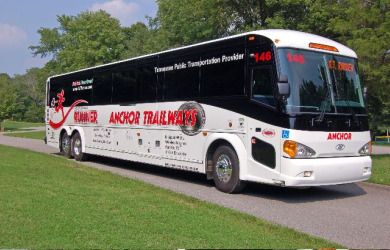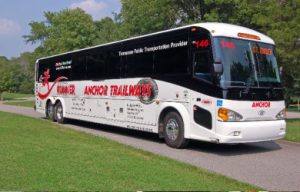
Section 5211(f) bridges the gap for regular scheduled coach service in critical regions
By David Hubbard
 Even with the encouraging study two years ago, The Return of the Intercity Bus, by Joseph P. Schwieterman and his team at DePaul University that illuminated the first significant rebirth of intercity bus activity in more than 40 years, and even with Megabus and Greyhound Bolt delivering an updated perspective of coach service to the traveling public, the suggestion that further growth in regular scheduled service is a tall order — but one that stills deserves consideration.
Even with the encouraging study two years ago, The Return of the Intercity Bus, by Joseph P. Schwieterman and his team at DePaul University that illuminated the first significant rebirth of intercity bus activity in more than 40 years, and even with Megabus and Greyhound Bolt delivering an updated perspective of coach service to the traveling public, the suggestion that further growth in regular scheduled service is a tall order — but one that stills deserves consideration.
It is essentially unreasonable in this day and age to think an affluent demographic will choose to ride a coach on trips more than a few hundred miles. But maybe with more enticement and enlightenment, operators could make a stronger case for more regional coach service. Schwieterman’s research stopped short of recognizing the independent operators serving smaller rural communities through federally subsidized grants. One program or another has been available for years. Section 5311(f) is the most current iteration.
With federal funds paying up to 80 percent of the costs, 5311(f) assistance provides funds to facilitate the coordination of rural transit connections between small transit operators and intercity bus carriers, and help cover costs to market rural intercity bus transportation services. 5311(f) capital assistance grants are available each year to motorcoach operators to purchase buses, vans, radios, wheelchair lifts, computers and other equipment necessary to maintain regularly scheduled transportation service to and from rural non-urban areas.
The grant also may go toward intercity bus shelters, joint-use stops, intermodal facilities and bus depots, as well as performing preventive maintenance.
Administered through state DOTs, 5311(f) money is available each year, though grant schedules and eligibility varies from state to state, each with its own application forms and processes. Interested operators should meet with their respective state DOT for grant schedules and proof of eligibility. Depending on the intended route service, the process may require coordinating with more than one state DOT.
Charter and tour services are not eligible for 5311(f) funding since they do not meet the definition of intercity service, nor provide operational support for intercity service. Similarly, commuter service that provides daily work trips within the local commuting area does not meet the definition of intercity service and is ineligible for this grant.
Using 5311(f) funding, Anchor Trailways and Tours, Nashville, TN, launched daily round-trip motorcoach service in July between Lawrenceburg and Nashville. The Tennessee Department of Transportation Multimodal Transportation Resource Division administers the $2.5 million federal grant to help the Anchor Trailways Runner provide transportation options to citizens in southern middle Tennessee who do not currently have access to daily scheduled transit routes to major cities.
The new ATRunner service connects to Metro Transit Agency buses from Lawrenceburg, Ethridge, Columbia, Spring Hill, Franklin and Nashville, and includes stops at the Clement Landport, the Greyhound station in downtown Nashville, as well as Nashville International Airport.
“A great many people along the route tell us this service is long overdue,” says Anchor Trailways founder John Stancil. “Now a wide range of travelers who rode the bygone greyhound service can enjoy renewed access on modern upgraded system.”
Minnesota-based Jefferson Lines has been such a participant for at least 25 years. Named for the Jefferson Highway, a dirt road from Winnipeg to New Orleans, regular scheduled service was its mission when the company launched 90 years ago, hinting at the types of programs to come. The third generation of the founding Zelle family now manages the Jefferson operation.
“Every state is different, but the thread of connection in these programs is their successful collaborations to make the rural connection, say Jefferson Lines president, Charles Zelle. “As more transportation entities discuss how to expand and connect transportation modes, I think many city transit agencies are actually discovering our participation is not taking any business away, and are more willing to engage in partnerships with private operators.”
He says the passengers are not the least bit concerned if it is a public or private entity taking them where they need to go. Zelle and veterans like him envision greater opportunities for coach operators willing to engage in regular scheduled service, but says they come with matching challenges.
“It is a very dynamic aspect of the coach industry,” says Zelle. “I think over time people are going to realize driving a private vehicle is not as convenient as it once was. Fuel costs, urban policies and environmental issues could begin to point the way to more regular scheduled coach service.”
It is safe to say this type of operation is not for the feint of heart. Establishing scheduled service routes is tedious work and tough to build the business to sustainable level. Most of those tenacious to maintain route service believe more opportunities exist, particularly with a refreshed image of motorcoach travel playing to the current economic climate, fuel prices and environmental concerns.
Fullington Trailways, Clearfield, PA, has been a grant participant since 1981, providing intercity bus service for much of central Pennsylvania, traveling to end point destinations in Pittsburgh, Wilkes-Barre and Harrisburg, PA; and Buffalo, NY, and intermodal connections to the rest of the country. Company vice president Milt Weisman would remind anyone considering such a move that federal subsidies such as 5311(f) is just that — a subsidy to routinely provide transportation, whether its for 56 passengers or only five or six.
“This type service takes a lot of careful research to see what is a true business opportunity,” he says. “Unfortunately, without the subsidy we probably wouldn’t be able to sustain the service that we are able to provide.”
Zelle, Weissman and other operators running rural service under 5311(f) agree the program is a worthy public-private partnership. He says if done right the funding accomplishes the goals of both sides, business opportunities for the independent operator and improved service from the Department of Transportation.
With more coaxing maybe a more coach-savvy public will encourage more operators to explore this niche.

Security at airports, whereby everyone is required to romove hats, jackets, coats, vests, belts, shoes, empty pockets, & remove amenities from carry-on baggage which used to hold razors, cosmetics, water bottles, and other personal effects, is already driving many travellers to either drive their own vehicles, or ride the bus. Once gasoline reaches the $5 per gallon mark in the USA (already that high in many Canadian Cities), the bus will see increased ridership.